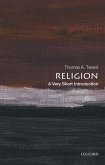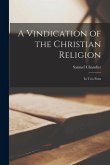Gary E Kessler
Studying Religion: An Introduction Through Cases
Gary E Kessler
Studying Religion: An Introduction Through Cases
- Broschiertes Buch
- Merkliste
- Auf die Merkliste
- Bewerten Bewerten
- Teilen
- Produkt teilen
- Produkterinnerung
- Produkterinnerung
Through the use of thought-provoking case studies, summaries, and review questions, this introductory level text shows students how to engage in the academic, objective study of religion and helps instructors address some of the typical problems they encounter when introducing students to the study of religion. Kessler guides students through an unbiased and varied study of religious beliefs and practices such as sacred power, myths and rituals, religious art, the problem of evil, and the relationship between religion and morality. The text also addresses issues of gender and religious institutionalization.…mehr
Andere Kunden interessierten sich auch für
![Religion: A Very Short Introduction Religion: A Very Short Introduction]() Thomas A. TweedReligion: A Very Short Introduction8,99 €
Thomas A. TweedReligion: A Very Short Introduction8,99 €![Theory of Right, Duties and Religion: Translation, With a Supplementary Theory of Right, Duties and Religion: Translation, With a Supplementary]() Benjamin C. Bur Wilhelm Friedrich HegelTheory of Right, Duties and Religion: Translation, With a Supplementary17,99 €
Benjamin C. Bur Wilhelm Friedrich HegelTheory of Right, Duties and Religion: Translation, With a Supplementary17,99 €![The Catholic Religion: A Manual of Instruction for Members of the Anglican Church The Catholic Religion: A Manual of Instruction for Members of the Anglican Church]() Vernon StaleyThe Catholic Religion: A Manual of Instruction for Members of the Anglican Church28,99 €
Vernon StaleyThe Catholic Religion: A Manual of Instruction for Members of the Anglican Church28,99 €![A Vindication of the Christian Religion: in Two Parts A Vindication of the Christian Religion: in Two Parts]() Samuel ChandlerA Vindication of the Christian Religion: in Two Parts28,99 €
Samuel ChandlerA Vindication of the Christian Religion: in Two Parts28,99 €![The Clinical Causes of Cancer of the Breast and Its Prevention: With Analyses of a Hundred Cases The Clinical Causes of Cancer of the Breast and Its Prevention: With Analyses of a Hundred Cases]() The Clinical Causes of Cancer of the Breast and Its Prevention: With Analyses of a Hundred Cases17,99 €
The Clinical Causes of Cancer of the Breast and Its Prevention: With Analyses of a Hundred Cases17,99 €![Discourses Relating to the Evidences of Revealed Religion: Delivered in the Church of the Universalists, at Philadelphia, 1796, and Published at the R Discourses Relating to the Evidences of Revealed Religion: Delivered in the Church of the Universalists, at Philadelphia, 1796, and Published at the R]() Joseph PriestleyDiscourses Relating to the Evidences of Revealed Religion: Delivered in the Church of the Universalists, at Philadelphia, 1796, and Published at the R29,99 €
Joseph PriestleyDiscourses Relating to the Evidences of Revealed Religion: Delivered in the Church of the Universalists, at Philadelphia, 1796, and Published at the R29,99 €![A History of Religion: Or, the Evidences for the Divinity of the Christian Religion As Furnished by Its History A History of Religion: Or, the Evidences for the Divinity of the Christian Religion As Furnished by Its History]() Joseph DeharbeA History of Religion: Or, the Evidences for the Divinity of the Christian Religion As Furnished by Its History34,99 €
Joseph DeharbeA History of Religion: Or, the Evidences for the Divinity of the Christian Religion As Furnished by Its History34,99 €-
-
-
Through the use of thought-provoking case studies, summaries, and review questions, this introductory level text shows students how to engage in the academic, objective study of religion and helps instructors address some of the typical problems they encounter when introducing students to the study of religion. Kessler guides students through an unbiased and varied study of religious beliefs and practices such as sacred power, myths and rituals, religious art, the problem of evil, and the relationship between religion and morality. The text also addresses issues of gender and religious institutionalization.
Hinweis: Dieser Artikel kann nur an eine deutsche Lieferadresse ausgeliefert werden.
Hinweis: Dieser Artikel kann nur an eine deutsche Lieferadresse ausgeliefert werden.
Produktdetails
- Produktdetails
- Verlag: McGraw Hill LLC
- 3rd edition
- Seitenzahl: 384
- Erscheinungstermin: 9. November 2007
- Englisch
- Abmessung: 230mm x 166mm x 14mm
- Gewicht: 485g
- ISBN-13: 9780073386591
- ISBN-10: 0073386596
- Artikelnr.: 23580496
- Herstellerkennzeichnung
- Libri GmbH
- Europaallee 1
- 36244 Bad Hersfeld
- gpsr@libri.de
- Verlag: McGraw Hill LLC
- 3rd edition
- Seitenzahl: 384
- Erscheinungstermin: 9. November 2007
- Englisch
- Abmessung: 230mm x 166mm x 14mm
- Gewicht: 485g
- ISBN-13: 9780073386591
- ISBN-10: 0073386596
- Artikelnr.: 23580496
- Herstellerkennzeichnung
- Libri GmbH
- Europaallee 1
- 36244 Bad Hersfeld
- gpsr@libri.de
Preface
Chapter 1: Thinking about Being a Student of Religion
1.1 Insider's and Outsider's Perspectives
1.2 Qualities Worth Having
1.3 Why Study Religion?
Review Questions
Explorations
Suggestions for Further Reading
Internet Resources
Chapter 2: On Defining and Studying Religion
2.1 Marks of a Good Definition
2.2 Two Definitions
2.3 Is Secular Humanism a Religion?
2.4 A Simple Map of the Field
2.5 Goals and Methods
2.6 Fieldwork
2.7 Controversy
Review Questions
Explorations
Suggestions for Further Reading
Internet Resources
Chapter 3: Sacred Power
3.1 Two Case Studies
3.2 Comparison
3.3 Forms of Sacred Power
3.4 Agnosticism and Atheism
Review Questions
Research Case: Ganesha
Questions on the Case of Ganesha
Suggestions for Further Reading
Internet Resources
Chapter 4: Myth as Sacred Story
4.1 Two Case Studies
4.2 Comparison
4.3 Types and Functions
4.4 Theories of Myth
4.5 Myth and Science
Review Questions
Research Case: The Primal Man
Questions on the Case of the Primal Man
Suggestions for Further Reading
Internet Resources
Chapter 5: Ritual as Sacred Action
5.1 Two Case Studies
5.2 Comparison
5.3 Types and Functions
5.4 Sacrifice and Violence
5.5 Magic, Performatives, and Ritual
5.6 Myth and Ritual
Review Questions
Research Case: Seder
Questions on the Case of the Seder
Suggestions for Further Reading
Internet Resources
Chapter 6: Sacred Space, Time, and Art
6.1 Two Case Studies
6.2 Comparison
6.3 Features of Sacred Space and Time
6.4 Glimpsing the Sacred
Review Questions
Research Case: The Cathedral of St. Andrew
Questions on the Case of the Cathedral of St. Andrew
Suggestions for Further Reading
Internet Resources
Chapter 7: Experiencing the Sacred
7.1 Two Case Studies
7.2 Comparison
7.3 Debates about the Nature of Religious Experiences
7.4 Shamanic Ecstasy
7.5 Mystical Techniques and States
7.6 Psychoanalytic Theories
Review Questions
Research Case: St. Teresa of Avila
Questions on the Case of St. Teresa of Avila
Suggestions for Further Reading
Internet Resources
Chapter 8: Explaining Evil
8.1 Two Case Studies
8.2 Comparison
8.3 Types of Theodicies
8.4 The Theological Problem of Evil
8.5 How Theodicies Work
Review Questions
Research Case: Manichaeism
Questions on the Case of Manichaeism
Suggestions for Further Reading
Internet Resources
Chapter 9: Religion and Morality
9.1 Two Case Studies
9.2 Comparison
9.3 Identifying and Legitimating Moral Norms
9.4 What are the Elements of a Religious Morality?
9.5 Retribution: Overcoming Moral Failure
Review Questions
Research Case: Jain Nonviolence
Questions on the Case of Jain Nonviolence
Suggestions for Further Reading
Internet Resources
Chapter 10: Religion and Politics
10.1 Two Case Studies
10.2 Comparison
10.3 Patterns of Political Engagement
Review Questions
Research Case: Shinto
Questions on the Case of Shinto
Suggestions for Further Reading
Internet Resources
Chapter 11: Organizing the Sacred
11.1 Two Case Studies
11.2 Comparison
11.3 Types of Religious Organizations
11.4 The Dilemmas of Institutionalization
11.5 Types of Authority
11.6 Scripture
11.7 Gender
11.8 Civil Religion
Review Questions
Research Case: Shinto
Questions on the Case of Shinto
Suggestions for Further Reading
Internet Resources
Chapter 12: Human Existence and Destiny
12.1 Two Case Studies
12.2 Comparison
12.3 Religions of Salvation and Society
12.4 What Is Wrong with Human Existence?
12.5 Three Paths to Salvation
12.6 Where Are We Going?
Review Questions
Research Case: Zen Buddhism
Questions on the Case of Zen Buddhism
Suggestions for Further Reading
Internet Resources
Chapter 13: Religious Diversity and Truth
13.1 Why Can't We All Get Along?
13.2 Exclusivism, Inclusivism, and More
13.3 What Is Truth?
13.4 Critical Tolerance and the Principle of Charity
Review Questions
Research Case: Baha'i
Questions on the Case of Baha'i
Suggestions for Further Reading
Internet Resources
Notes
Glossary
Index
Chapter 1: Thinking about Being a Student of Religion
1.1 Insider's and Outsider's Perspectives
1.2 Qualities Worth Having
1.3 Why Study Religion?
Review Questions
Explorations
Suggestions for Further Reading
Internet Resources
Chapter 2: On Defining and Studying Religion
2.1 Marks of a Good Definition
2.2 Two Definitions
2.3 Is Secular Humanism a Religion?
2.4 A Simple Map of the Field
2.5 Goals and Methods
2.6 Fieldwork
2.7 Controversy
Review Questions
Explorations
Suggestions for Further Reading
Internet Resources
Chapter 3: Sacred Power
3.1 Two Case Studies
3.2 Comparison
3.3 Forms of Sacred Power
3.4 Agnosticism and Atheism
Review Questions
Research Case: Ganesha
Questions on the Case of Ganesha
Suggestions for Further Reading
Internet Resources
Chapter 4: Myth as Sacred Story
4.1 Two Case Studies
4.2 Comparison
4.3 Types and Functions
4.4 Theories of Myth
4.5 Myth and Science
Review Questions
Research Case: The Primal Man
Questions on the Case of the Primal Man
Suggestions for Further Reading
Internet Resources
Chapter 5: Ritual as Sacred Action
5.1 Two Case Studies
5.2 Comparison
5.3 Types and Functions
5.4 Sacrifice and Violence
5.5 Magic, Performatives, and Ritual
5.6 Myth and Ritual
Review Questions
Research Case: Seder
Questions on the Case of the Seder
Suggestions for Further Reading
Internet Resources
Chapter 6: Sacred Space, Time, and Art
6.1 Two Case Studies
6.2 Comparison
6.3 Features of Sacred Space and Time
6.4 Glimpsing the Sacred
Review Questions
Research Case: The Cathedral of St. Andrew
Questions on the Case of the Cathedral of St. Andrew
Suggestions for Further Reading
Internet Resources
Chapter 7: Experiencing the Sacred
7.1 Two Case Studies
7.2 Comparison
7.3 Debates about the Nature of Religious Experiences
7.4 Shamanic Ecstasy
7.5 Mystical Techniques and States
7.6 Psychoanalytic Theories
Review Questions
Research Case: St. Teresa of Avila
Questions on the Case of St. Teresa of Avila
Suggestions for Further Reading
Internet Resources
Chapter 8: Explaining Evil
8.1 Two Case Studies
8.2 Comparison
8.3 Types of Theodicies
8.4 The Theological Problem of Evil
8.5 How Theodicies Work
Review Questions
Research Case: Manichaeism
Questions on the Case of Manichaeism
Suggestions for Further Reading
Internet Resources
Chapter 9: Religion and Morality
9.1 Two Case Studies
9.2 Comparison
9.3 Identifying and Legitimating Moral Norms
9.4 What are the Elements of a Religious Morality?
9.5 Retribution: Overcoming Moral Failure
Review Questions
Research Case: Jain Nonviolence
Questions on the Case of Jain Nonviolence
Suggestions for Further Reading
Internet Resources
Chapter 10: Religion and Politics
10.1 Two Case Studies
10.2 Comparison
10.3 Patterns of Political Engagement
Review Questions
Research Case: Shinto
Questions on the Case of Shinto
Suggestions for Further Reading
Internet Resources
Chapter 11: Organizing the Sacred
11.1 Two Case Studies
11.2 Comparison
11.3 Types of Religious Organizations
11.4 The Dilemmas of Institutionalization
11.5 Types of Authority
11.6 Scripture
11.7 Gender
11.8 Civil Religion
Review Questions
Research Case: Shinto
Questions on the Case of Shinto
Suggestions for Further Reading
Internet Resources
Chapter 12: Human Existence and Destiny
12.1 Two Case Studies
12.2 Comparison
12.3 Religions of Salvation and Society
12.4 What Is Wrong with Human Existence?
12.5 Three Paths to Salvation
12.6 Where Are We Going?
Review Questions
Research Case: Zen Buddhism
Questions on the Case of Zen Buddhism
Suggestions for Further Reading
Internet Resources
Chapter 13: Religious Diversity and Truth
13.1 Why Can't We All Get Along?
13.2 Exclusivism, Inclusivism, and More
13.3 What Is Truth?
13.4 Critical Tolerance and the Principle of Charity
Review Questions
Research Case: Baha'i
Questions on the Case of Baha'i
Suggestions for Further Reading
Internet Resources
Notes
Glossary
Index
Preface
Chapter 1: Thinking about Being a Student of Religion
1.1 Insider's and Outsider's Perspectives
1.2 Qualities Worth Having
1.3 Why Study Religion?
Review Questions
Explorations
Suggestions for Further Reading
Internet Resources
Chapter 2: On Defining and Studying Religion
2.1 Marks of a Good Definition
2.2 Two Definitions
2.3 Is Secular Humanism a Religion?
2.4 A Simple Map of the Field
2.5 Goals and Methods
2.6 Fieldwork
2.7 Controversy
Review Questions
Explorations
Suggestions for Further Reading
Internet Resources
Chapter 3: Sacred Power
3.1 Two Case Studies
3.2 Comparison
3.3 Forms of Sacred Power
3.4 Agnosticism and Atheism
Review Questions
Research Case: Ganesha
Questions on the Case of Ganesha
Suggestions for Further Reading
Internet Resources
Chapter 4: Myth as Sacred Story
4.1 Two Case Studies
4.2 Comparison
4.3 Types and Functions
4.4 Theories of Myth
4.5 Myth and Science
Review Questions
Research Case: The Primal Man
Questions on the Case of the Primal Man
Suggestions for Further Reading
Internet Resources
Chapter 5: Ritual as Sacred Action
5.1 Two Case Studies
5.2 Comparison
5.3 Types and Functions
5.4 Sacrifice and Violence
5.5 Magic, Performatives, and Ritual
5.6 Myth and Ritual
Review Questions
Research Case: Seder
Questions on the Case of the Seder
Suggestions for Further Reading
Internet Resources
Chapter 6: Sacred Space, Time, and Art
6.1 Two Case Studies
6.2 Comparison
6.3 Features of Sacred Space and Time
6.4 Glimpsing the Sacred
Review Questions
Research Case: The Cathedral of St. Andrew
Questions on the Case of the Cathedral of St. Andrew
Suggestions for Further Reading
Internet Resources
Chapter 7: Experiencing the Sacred
7.1 Two Case Studies
7.2 Comparison
7.3 Debates about the Nature of Religious Experiences
7.4 Shamanic Ecstasy
7.5 Mystical Techniques and States
7.6 Psychoanalytic Theories
Review Questions
Research Case: St. Teresa of Avila
Questions on the Case of St. Teresa of Avila
Suggestions for Further Reading
Internet Resources
Chapter 8: Explaining Evil
8.1 Two Case Studies
8.2 Comparison
8.3 Types of Theodicies
8.4 The Theological Problem of Evil
8.5 How Theodicies Work
Review Questions
Research Case: Manichaeism
Questions on the Case of Manichaeism
Suggestions for Further Reading
Internet Resources
Chapter 9: Religion and Morality
9.1 Two Case Studies
9.2 Comparison
9.3 Identifying and Legitimating Moral Norms
9.4 What are the Elements of a Religious Morality?
9.5 Retribution: Overcoming Moral Failure
Review Questions
Research Case: Jain Nonviolence
Questions on the Case of Jain Nonviolence
Suggestions for Further Reading
Internet Resources
Chapter 10: Religion and Politics
10.1 Two Case Studies
10.2 Comparison
10.3 Patterns of Political Engagement
Review Questions
Research Case: Shinto
Questions on the Case of Shinto
Suggestions for Further Reading
Internet Resources
Chapter 11: Organizing the Sacred
11.1 Two Case Studies
11.2 Comparison
11.3 Types of Religious Organizations
11.4 The Dilemmas of Institutionalization
11.5 Types of Authority
11.6 Scripture
11.7 Gender
11.8 Civil Religion
Review Questions
Research Case: Shinto
Questions on the Case of Shinto
Suggestions for Further Reading
Internet Resources
Chapter 12: Human Existence and Destiny
12.1 Two Case Studies
12.2 Comparison
12.3 Religions of Salvation and Society
12.4 What Is Wrong with Human Existence?
12.5 Three Paths to Salvation
12.6 Where Are We Going?
Review Questions
Research Case: Zen Buddhism
Questions on the Case of Zen Buddhism
Suggestions for Further Reading
Internet Resources
Chapter 13: Religious Diversity and Truth
13.1 Why Can't We All Get Along?
13.2 Exclusivism, Inclusivism, and More
13.3 What Is Truth?
13.4 Critical Tolerance and the Principle of Charity
Review Questions
Research Case: Baha'i
Questions on the Case of Baha'i
Suggestions for Further Reading
Internet Resources
Notes
Glossary
Index
Chapter 1: Thinking about Being a Student of Religion
1.1 Insider's and Outsider's Perspectives
1.2 Qualities Worth Having
1.3 Why Study Religion?
Review Questions
Explorations
Suggestions for Further Reading
Internet Resources
Chapter 2: On Defining and Studying Religion
2.1 Marks of a Good Definition
2.2 Two Definitions
2.3 Is Secular Humanism a Religion?
2.4 A Simple Map of the Field
2.5 Goals and Methods
2.6 Fieldwork
2.7 Controversy
Review Questions
Explorations
Suggestions for Further Reading
Internet Resources
Chapter 3: Sacred Power
3.1 Two Case Studies
3.2 Comparison
3.3 Forms of Sacred Power
3.4 Agnosticism and Atheism
Review Questions
Research Case: Ganesha
Questions on the Case of Ganesha
Suggestions for Further Reading
Internet Resources
Chapter 4: Myth as Sacred Story
4.1 Two Case Studies
4.2 Comparison
4.3 Types and Functions
4.4 Theories of Myth
4.5 Myth and Science
Review Questions
Research Case: The Primal Man
Questions on the Case of the Primal Man
Suggestions for Further Reading
Internet Resources
Chapter 5: Ritual as Sacred Action
5.1 Two Case Studies
5.2 Comparison
5.3 Types and Functions
5.4 Sacrifice and Violence
5.5 Magic, Performatives, and Ritual
5.6 Myth and Ritual
Review Questions
Research Case: Seder
Questions on the Case of the Seder
Suggestions for Further Reading
Internet Resources
Chapter 6: Sacred Space, Time, and Art
6.1 Two Case Studies
6.2 Comparison
6.3 Features of Sacred Space and Time
6.4 Glimpsing the Sacred
Review Questions
Research Case: The Cathedral of St. Andrew
Questions on the Case of the Cathedral of St. Andrew
Suggestions for Further Reading
Internet Resources
Chapter 7: Experiencing the Sacred
7.1 Two Case Studies
7.2 Comparison
7.3 Debates about the Nature of Religious Experiences
7.4 Shamanic Ecstasy
7.5 Mystical Techniques and States
7.6 Psychoanalytic Theories
Review Questions
Research Case: St. Teresa of Avila
Questions on the Case of St. Teresa of Avila
Suggestions for Further Reading
Internet Resources
Chapter 8: Explaining Evil
8.1 Two Case Studies
8.2 Comparison
8.3 Types of Theodicies
8.4 The Theological Problem of Evil
8.5 How Theodicies Work
Review Questions
Research Case: Manichaeism
Questions on the Case of Manichaeism
Suggestions for Further Reading
Internet Resources
Chapter 9: Religion and Morality
9.1 Two Case Studies
9.2 Comparison
9.3 Identifying and Legitimating Moral Norms
9.4 What are the Elements of a Religious Morality?
9.5 Retribution: Overcoming Moral Failure
Review Questions
Research Case: Jain Nonviolence
Questions on the Case of Jain Nonviolence
Suggestions for Further Reading
Internet Resources
Chapter 10: Religion and Politics
10.1 Two Case Studies
10.2 Comparison
10.3 Patterns of Political Engagement
Review Questions
Research Case: Shinto
Questions on the Case of Shinto
Suggestions for Further Reading
Internet Resources
Chapter 11: Organizing the Sacred
11.1 Two Case Studies
11.2 Comparison
11.3 Types of Religious Organizations
11.4 The Dilemmas of Institutionalization
11.5 Types of Authority
11.6 Scripture
11.7 Gender
11.8 Civil Religion
Review Questions
Research Case: Shinto
Questions on the Case of Shinto
Suggestions for Further Reading
Internet Resources
Chapter 12: Human Existence and Destiny
12.1 Two Case Studies
12.2 Comparison
12.3 Religions of Salvation and Society
12.4 What Is Wrong with Human Existence?
12.5 Three Paths to Salvation
12.6 Where Are We Going?
Review Questions
Research Case: Zen Buddhism
Questions on the Case of Zen Buddhism
Suggestions for Further Reading
Internet Resources
Chapter 13: Religious Diversity and Truth
13.1 Why Can't We All Get Along?
13.2 Exclusivism, Inclusivism, and More
13.3 What Is Truth?
13.4 Critical Tolerance and the Principle of Charity
Review Questions
Research Case: Baha'i
Questions on the Case of Baha'i
Suggestions for Further Reading
Internet Resources
Notes
Glossary
Index








